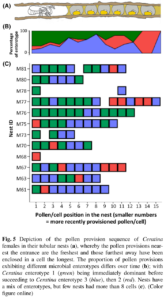Here, I look at the microbiomes in wild and managed bees. Microbiomes are the communities of microbes that live in the digestive tract of bees. We believe many of these microbes provide benefits to the host bee; and honey bees in particular are known to have a consistent community of microbes. However, research of the honey bee microbiome can only provide limited insight into wild bees. By looking at the microbiomes in the closely related Ceratina bees and distantly related Megalopta we examine how different the microbiomes are between different bees. We then look to see if the microbes found in the bee collected pollen is similar to the microbiomes.

This is particularly interesting in the Ceratina pollen which is provisioned in brood cells in sequence so we could link it to its time since being regurgitated by the bee
Unlike honey bees, whose gut microbial community differs compared to their pollen, Ceratina adults and pollen largely share a similar microbial composition. This suggests the environmental transmission of microbes from flowers is likely to be important for wild bees like Ceratina who do not benefit from social transmission like honeybees do. We go on to discuss the consequences of diversity in core microbiota between bee genera and their associations with pollen in relation to identifying potentially beneficial microbial taxa in wild bees to aid the conservation of wild, understudied, non- model bee species.
click here to learn more from this study